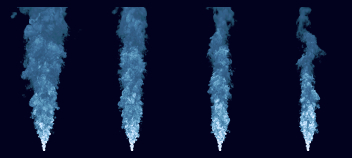
Home |
Research |
Publications |
People |
Software |
Links |
Downloads |
Turbulent Jets with Off-Source Heating
Introduction
There is a latent heat release associated with condensation in atmospheric plumes during cloud formation. This introduces a source of buoyancy that changes the entrainment behavior of the plume.
Motivated by this anomalous entrainment in cumulus clouds, Bhat and Narasimha (1996) used a laboratory experiment to examine entrainment into turbulent jets that were subject to volumetric heating away from the jet source.
The entrainment assumption introduced by Morton, Taylor and Turner (1956) asserts that the rate that fluid is entrained is proportional to a characteristic velocity of the jet.
Buoyancy leads to an acceleration of the jet, and so by the entrainment assumption, the entrainment of fluid should also increase. However, field observations report that it decreases, possibly to zero.
Bhat and Narasimha found a dramatic change in the jet behavior, and a drastic reduction in the spread rate and mass flux. It was concluded that the assumption of a constant entrainment coefficient was not applicable to this flow.
J. C. R. Hunt (1996) suggested that an increase in the relative turbulent intensity could lead to a decrease in entrainment. However, a decrease in relative turbulent intensity was observed in the experiments, and so it was concluded that Hunt's proposal was not verified by the experiments.
Simulations
The still above shows the injected tracer. An animation can be found here mpeg 57MB. (Right click and select "Save" if you have problems playing the movie)
The simulations were run with a base grid of 128x128x192 with two levels of refinement to give an effective resolution of 512x512x768.
The data from the simulations has allowed for a detailed examination of the entrainment behavior, in particular in response to the heating. The results will be published in an upcoming paper, along with a reassessment of the theory and experimental data. It will be shown that the original suggestion of Hunt can be verified, not only in the simulations, but also in the experimental data of Bhat and Narasimha. Many of the other aspects of the flow that are not understood will also be explained.
Please direct any questions to Andy Aspden.
External References
A. Agrawal and A.K. Prasad. Evolution of a turbulent jet subjected to volumetric heating. Journal of Fluid Mechanics, Volume 511. (2004)
G.S. Bhat and R. Narasimha. A volumetrically heated jet: large-eddy structure and entrainment characteristics. Journal of Fluid Mechanics, Volume 325. (1996)
J.C.R. Hunt. Atmospheric jets and plumes. Recent Research Advances in the Fluid Mechanics of Turbulent Jets and Plumes, Proc. NATO Advanced Study Institute, Viano di Castello, Portugal. Editors, P.A. Davies and M.J. Valente. Kluwer Academic, Netherlands. (1994)
B. R. Morton and G. I. Taylor and J. S. Turner. Turbulent Gravitational Convection from Maintained and Instantaneous Sources. Royal Society of London Proceedings Series A, Volume 234. (1956)
